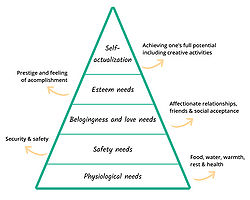Intrinsic and Extrinsic motivation
Contents |
Abstract
Motivation can be defined as “the need or reason for doing something.”[1] Deep down, what do people want? Why do people adhere to norms? Is everyone equally motivated by money, social life and fame?
The purpose of this article is to dive into the concept of intrinsic and extrinsic motivations, the 16 universal human needs, and their practical implication. Starting from the theory of human motivation of A.H. Maslow, this paper shows the characteristics of basic needs and their hierarchy of prepotency arrangement. Subsequently, the distinction of intrinsic and extrinsic motivations is carried out and the concept of multifaceted motivation is tackled.
Theory of human motivation – Maslow

Maslow’s pyramid[3] was created in 1943 and in a graphic way, categorizes human motivations into five sets of goals, which are called basic needs. These are physiological, safety, love, esteem, and self-actualization. Additionally, the author suggests that the needs must be satisfied in ascending order from the bottom of the pyramid.
According to this theory, "as needs are met, new ones emerge". This is why the basic needs are arranged according to its hierarchy of prepotency. In this sense, the pyramid shows a path that must be fulfilled to achieve happiness. The search for desired elements will be what generates motivation. It also suggests that the basic goals are related to each other, meaning that if all needs are unsatisfied and the organism is then dominated by physiological needs, all further needs may become non-existent or be pushed into the background. A person that is extremely tired and has not slept for a drastic amount of time, its organism will focus all its energy on achieving restful sleep.
Limitations
Many of the investigations associated with "The theory of human needs" neither deliver data that can certify nor guarantee the success of Maslow´s pyramid. The idea that the hierarchy order is fixed, does not apply equally to everybody according to its personality, aspirations, or context. It is necessary also to highlight that a routine or habit that has satisfied a specific need for a long period of time, may lead to a reversal hierarchy effect as this need becomes undervalued. Furthermore, is more realistic that a need is not 100% fulfilled until a new one emerges and the degree of relative satisfaction depends on each individual.
Intrinsic Motivations
Extrinsic Motivations
Multifaceted Motivations
Annotated bibliography
- ↑ Cambridge University, Cambridge Advanced Learner's Dictionary & Thesaurus, https://dictionary.cambridge.org/dictionary/english/motivation .
- ↑ Ruben Turienzo,El pequeño libro de la motivación,2016.
- ↑ A.H. Maslow, A theory of Human Motivation.
Cite error: <ref> tag with name "MotivationKasser" defined in <references> is not used in prior text.
Cite error: <ref> tag with name "Motivation" defined in <references> is not used in prior text.
Cite error: <ref> tag with name "MotivationKreps" defined in <references> is not used in prior text.
Cite error: <ref> tag with name "Motivation" defined in <references> is not used in prior text.